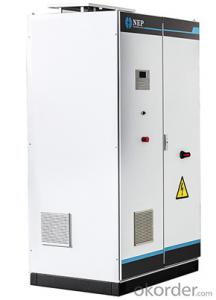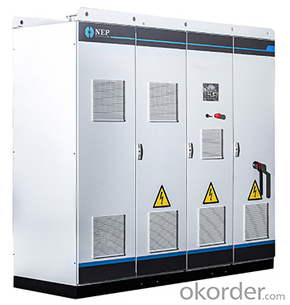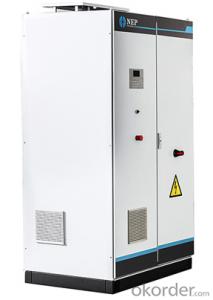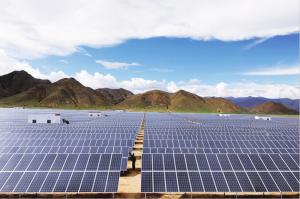Trace Solar Inverter Grid Tied BDE-630K
- Loading Port:
- Qingdao
- Payment Terms:
- TT OR LC
- Min Order Qty:
- 10 unit
- Supply Capability:
- 1000 unit/month
OKorder Service Pledge
OKorder Financial Service
You Might Also Like
Description:
Microinverter services respectly in every solar panel, a solar micro-inverter, converts direct current (DC) electricity from a single solar panel to alternating current (AC). The electric power from several micro-inverters is combined and fed into an existing electrical grid. Micro-inverters contrast with conventional string or central inverter devices, which are connected to multiple solar panels.
Characteristic & Advantages:
More Energy Harvest: Distributed MPPT allows10~25% more energy harvest
Simple: Modularized,single ac cable to the house
Reliability: Longer life time and almost 100% operation hours
Security: No high Voltage, makes safter environments
Inteligent : Monitoring each module and enlarge the efficency of the generation
Savings: No dc components and significantly save labor cost
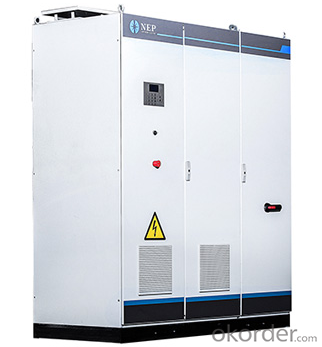
Datasheet:
★ Advanced digital control techniques using the latest DSP Optimized anti-islanding technique for the highest system reliability.
★Optimized Maximum Power Point Tracking technique guarantees the maximum power output from the PV array User oriented Graphic User Interface (GUI) on an integrated.
★ 128*64 graphic VFD and a keypad panel..
★Support multiple communication protocols, including RS232/RS485/Ethernet/Zigbee etc.
★ Complete protection functions to protect against reverse DC polarity,over temperature,over current,short cirucuit,over/under voltage,anti-islanding,etc.
★ Can be used at a wide range of environment temperatures and high altitude.
★ Automatically power-on in the morning and enter a low power mode at night. No local operators required for daily operation
- Q: Can a solar inverter be connected to a battery storage system?
- Yes, a solar inverter can be connected to a battery storage system. This allows excess solar energy generated during the day to be stored in the batteries and used later when there is no sunlight, providing a reliable source of power.
- Q: How does a solar inverter handle grid synchronization during startup?
- During startup, a solar inverter handles grid synchronization by employing a process called anti-islanding. The inverter continuously monitors the grid voltage and frequency to ensure that it matches the required standards. It remains disconnected from the grid until it detects stable and synchronized grid conditions. Once the grid parameters are within the acceptable range, the inverter synchronizes its output waveform with the grid and gradually ramps up its power production. This ensures a smooth and safe integration of the solar system with the grid, preventing any potential issues like islanding or instability.
- Q: Can a solar inverter be used with dual-axis solar trackers?
- Yes, a solar inverter can be used with dual-axis solar trackers. A solar inverter is responsible for converting the direct current (DC) generated by the solar panels into alternating current (AC) that can be used to power electrical devices or be fed into the grid. The dual-axis solar trackers enable the solar panels to follow the sun's movement in both horizontal and vertical directions, maximizing their exposure to sunlight throughout the day. The solar inverter can still perform its function of converting DC to AC regardless of the type of solar tracking system used.
- Q: Can a solar inverter be used with solar-powered outdoor lighting?
- Yes, a solar inverter can be used with solar-powered outdoor lighting. A solar inverter converts the direct current (DC) generated by the solar panels into alternating current (AC) that is required to power the outdoor lighting fixtures. This allows for efficient and reliable operation of the solar-powered lighting system.
- Q: Is it possible to upgrade my existing solar inverter without replacing the entire system?
- Yes, it is possible to upgrade your existing solar inverter without replacing the entire system. In some cases, you may be able to replace the inverter with a more advanced model that offers improved efficiency or additional features. However, it is important to consult with a professional to ensure compatibility and proper installation.
- Q: How does a solar inverter convert DC to AC power?
- A solar inverter converts direct current (DC) power generated by solar panels into alternating current (AC) power that can be used to power appliances and feed into the electrical grid. It does this through a two-step process. Firstly, the DC power from the solar panels is converted into a high-frequency AC signal using power electronics. Then, this AC signal is transformed into the desired AC output voltage and frequency using pulse width modulation techniques. This allows for efficient and reliable conversion of solar energy into usable electricity.
- Q: Can a solar inverter be used in conjunction with a power optimizer?
- Yes, a solar inverter can be used in conjunction with a power optimizer. Power optimizers are devices that are typically installed at each solar panel to maximize energy production and improve overall system performance. They can work together with a solar inverter to enhance the efficiency of the solar power system by individually optimizing the power output of each panel.
- Q: How does the power factor correction affect the performance of a solar inverter?
- Power factor correction can significantly improve the performance of a solar inverter. By correcting the power factor, the inverter can optimize the energy conversion process, resulting in increased efficiency and reduced losses. This correction helps in minimizing reactive power, improving voltage stability, and enhancing the overall power quality of the inverter. Ultimately, power factor correction ensures that the solar inverter operates at its maximum capacity, leading to improved performance and increased energy output.
- Q: How does a solar inverter protect against voltage fluctuations?
- A solar inverter protects against voltage fluctuations by continuously monitoring and regulating the electrical output from the solar panels. It adjusts the voltage and frequency of the direct current (DC) generated by the panels to match the utility grid's alternating current (AC) voltage requirements, ensuring a stable and consistent power supply. Additionally, solar inverters have built-in protection mechanisms such as surge suppression and overvoltage/undervoltage detection, which safeguard the system from voltage spikes or drops, preventing any potential damage to the solar panels or electrical devices.
- Q: Are there any government incentives available for solar inverters?
- Yes, there are government incentives available for solar inverters. These incentives vary by country and region, but often include tax credits, grants, and rebates to encourage the adoption of solar energy. It is recommended to check with local authorities or consult a solar energy professional to determine the specific incentives available in a particular area.
Send your message to us
Trace Solar Inverter Grid Tied BDE-630K
- Loading Port:
- Qingdao
- Payment Terms:
- TT OR LC
- Min Order Qty:
- 10 unit
- Supply Capability:
- 1000 unit/month
OKorder Service Pledge
OKorder Financial Service
Similar products
Hot products
Hot Searches
Related keywords
